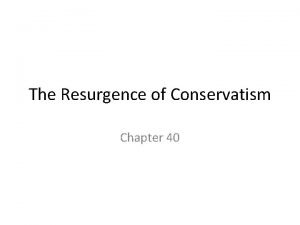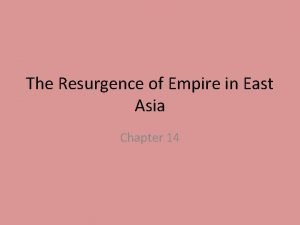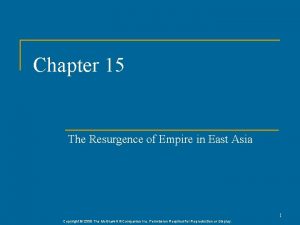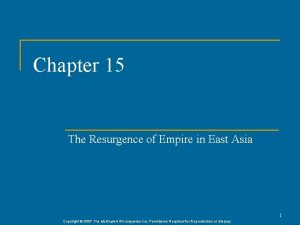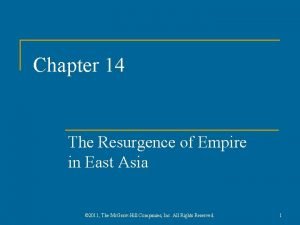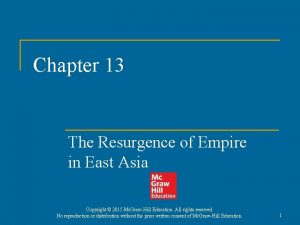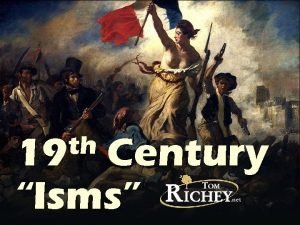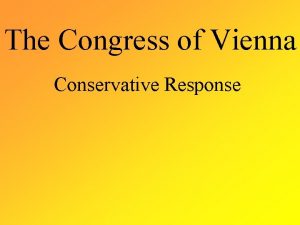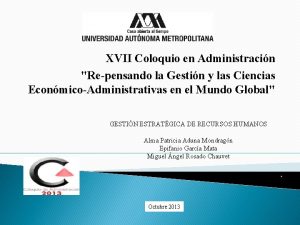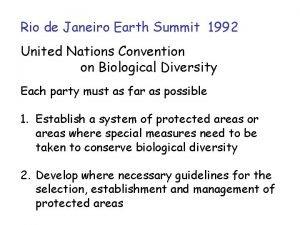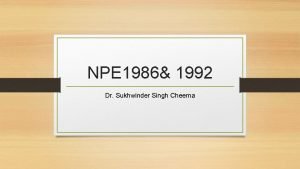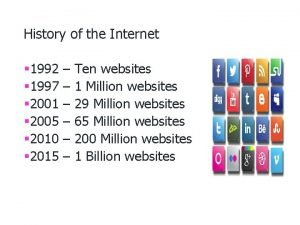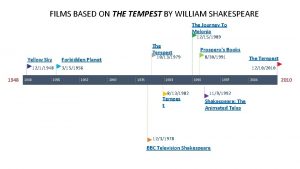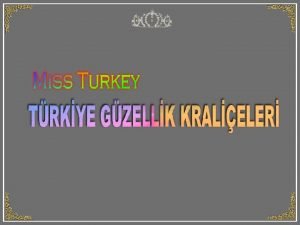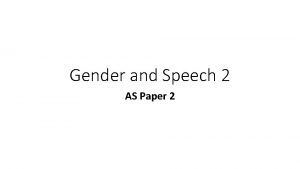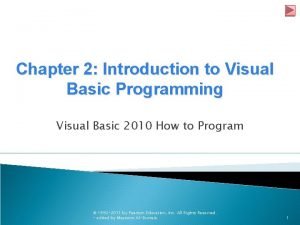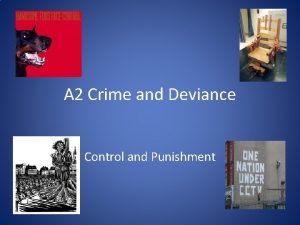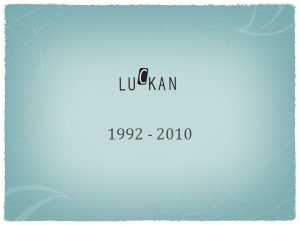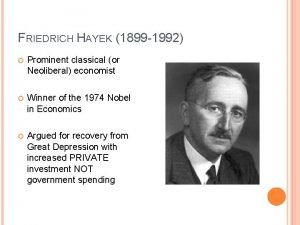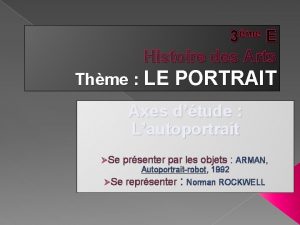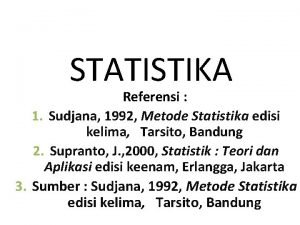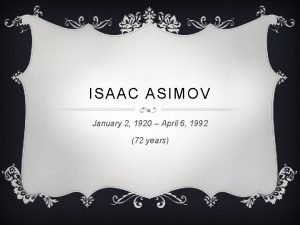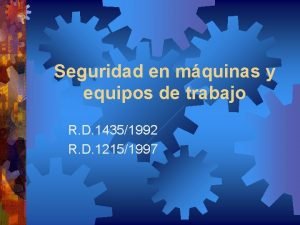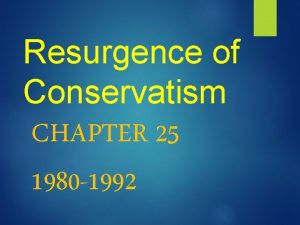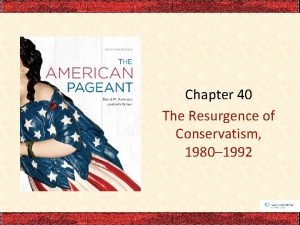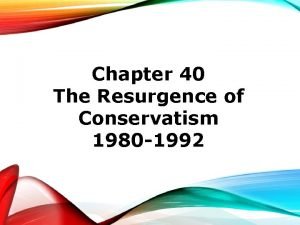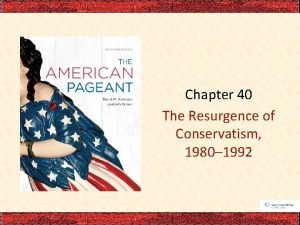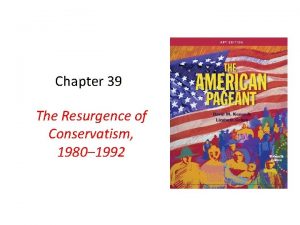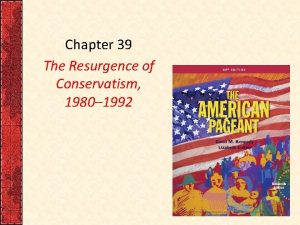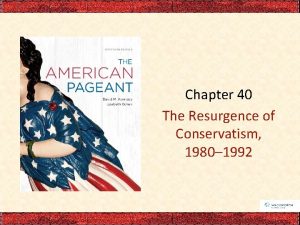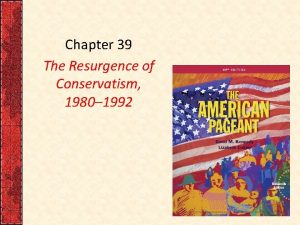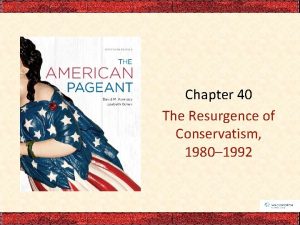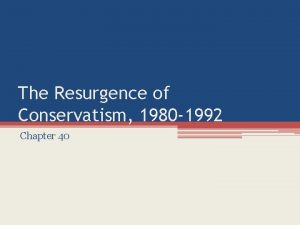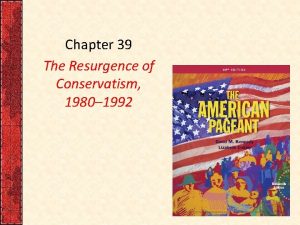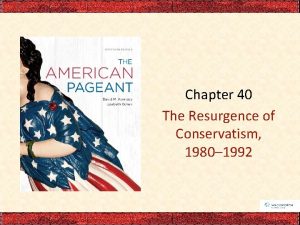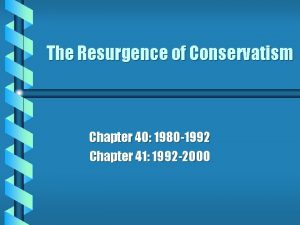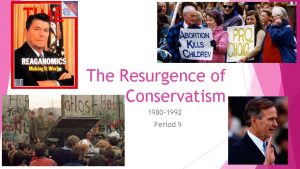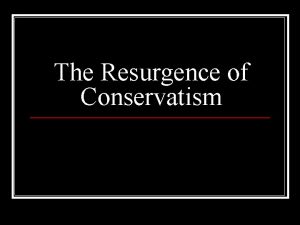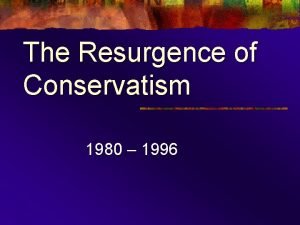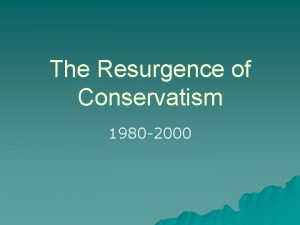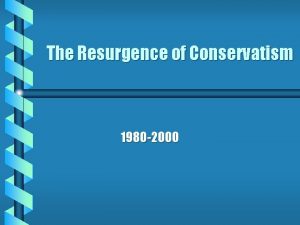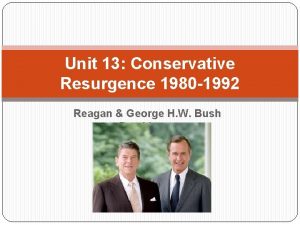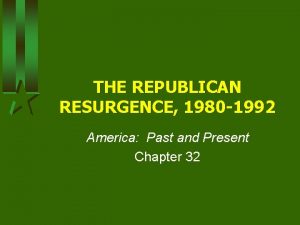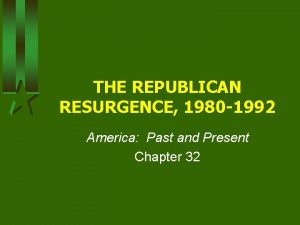Chapter 39 The Resurgence of Conservatism 1980 1992













































- Slides: 45

Chapter 39 The Resurgence of Conservatism 1980 -1992

Conservatism in the 1980 s Anti-government “New Right” Evangelical Christians Focused on issues like abortion, pornography, homosexuality, feminism, and affirmative action

Election of 1980, Ronald Reagan Raised in an environment prior to 1960 s upheaval Champion of the “common man” Impoverished Irish family B-grade actor President of the Screen Actors Guild Helped root out communists during the Mc. Carthy era Governor of California between 1966 -1974

The Election of 1980, Ronald Reagan cont. Jimmy Carter facing heavy criticism Massive inflation Mismanagement of national affairs The liberal faction of the party grew behind Senator Edward Kennedy Too left wing Suspicions after a young female assistant died in a Kennedy involved car crash Reagan went on offensive with Carter administration couldn’t hold under popularity of Reagan

● Carter showed dignity in defeat ○ Last Act in Office preserved 100 million acres in Alaska ○ Became renowned humanitarian and human rights activist


The Reagan Revolution Inauguration triumphal due to release of hostages by Iran Reagan held devotion to fiscal fitness and dismantling of the welfare state Smaller government, less bureaucracy, and freer markets Found ally in first female Prime Minister of Britain, Margaret Thatcher Reduce power of unions and government involved business

Four decades prior to Reagan, the U. S. government had been advancing New Deal and Great Society Programs Countercurrent began in California with Proposition 13 Slashed property taxes and forced cuts in government spending With great enthusiasm and effectiveness Reagan proposed new federal budget Cut spending by $35 billion Found support in Southern Conservative Democrats(boll-weevils)

The Battle of the Budget Congress passed Presidential budget, beginning a massive political change in the power of congress Regan then proposed reductions in marginal taxes Boll-weevil support Reagan’s mastery of mass media Economic reform based on Supply-Side Economics or Reaganomics Budgetary discipline and tax reduction would stimulate investment, productivity, and growth

● Unemployment peaked in 1982, along with businesses and banks folding ● Automobile industry now facing Japanese imports, lost massive amounts of money ● Supply-siders waited until economic recovery began in 1983 ○ Income gaps widened ○ “Yuppies” emerged ■ Showcasing the pursuit of wealth and materialism

Healthy economic growth was due to increased military spending, not supply-side economics $2 trillion flowed into military expenditures Kept interest high and inflation continued to rise Federal deficits fell to $100 billion

Reagan Renews the Cold War ● Reagan denounced the Soviet Union as the “focus of evil in the modern world” ○ Willing to negotiate only when the U. S. was in a position of strength ■ Entered new round of expensive arms race ● USSR in no state to engage in arms race, began to comply with the U. S. ● Huge risk by Reagan ● The rise of another arms race dawned with the Strategic Defense Initiative(SDI) ○ Orbiting battle stations with the capability to vaporize and destroy nuclear missiles ○ Raised stakes of the Cold War

Soviet Union crushed massive Polish union through martial law Reagan slapped sanctions on the USSR Soviet Union stilled ruled by aged oligarchs Several of whom died while Reagan was in office Tensions rose when Korean Passenger Airliner shot down by the USSR and Soviet Bloc athletes boycotted Los Angeles Olympics in 1984

Troubles Abroad: Middle East Israel strained relations with U. S. as they encouraged more settlements in disputed area Further escalating the problem when Israel invaded Lebanon Palestinians subdued but Lebanon in chaos Reagan sent American troops for Peacekeeping effort, but failed when two hundred marines died in suicide bomber attack

Troubles Abroad: Central America Anti-american Sandinistas disposed long-time dictator in Nicaragua Reagan accused Nicaragua of being a Soviet and Cuban military base Satellite photos of Sandinistas moving weapons into war-torn El Salvador Reagan sent military advisors to help pro-american government, or the “Contras” Reagan invaded recently marxist island of Grenada U. S. held military dominance in the Caribbean

Round Two for Reagan Little opposition for his bid for the White House Bolstered economy and strong front abroad Democratic nominee Walter Mondale and Geraldine Ferraro, first female to appear on a major ticket

● Reagan contended against Mikhail Gorbachev ○ Recently installed chairman of the Soviet Communist Party ○ Personable, energetic, imaginable, and committed to reform ● Gorbachev implicated two major policies: ○ Glasnost-aimed at breaking up secretiveness and repressiveness of the USSR by allowing free speech and some political liberty ○ Perestroika-revive Soviet economy by adopting several free-market practices of the capitalist west

Glasnost and Perestroika both required a decrease in military spending and a redirection of supplies to the civilian economy Gorbachev also ceased the deployment of Intermediate-range Nuclear Forces Met with Ronald Reagan about this specific issue Met several other times to finalize Intermediate-Range Nuclear Forces Treaty banning these weapons from Europe Reagan Administration also provided backing to Corazon Aquinos’ ouster of the Filipino dictator Marcos Reagan ordered lightning strike bombing of Libya for terrorist ties

First in Geneva, November 1985 Summit Conferences Second in Reykjavik, October 1986 Third in Washington D. C. , December 1987 Fourth in Moscow 1988

President Reagan and Gorbachev shake hands at a summit meeting in Moscow.

The Iran-Contra Affair ● Increase in number of American hostages by muslim extremist groups and the Sandinista government in Nicaragua plagued Reagan ○ Congress repeatedly refused to give aid to the Contras ● Unannounced to the public, several American officials saw a link between these two issues ○ American diplomats arranged covert arms deals with Iran for the release of captive Americans and a substantial amount of money ○ The money was then given to the Contras to help fight the Sandinistas ■ Both actions were against congressional ban

● The news of these underhand deals broke in November 1986, sparking massive controversy ● Reagan claimed he knew nothing of his subordinates activities, greatly reflecting the Watergate Scandal ○ No evidence was found that the President lied, however the President was highly ridiculed for his apparent ignorance of the situation

● The Iran-Contra Affair overshadowed the great strides the Reagan Administration made with the Soviet Union and made President Reagan look like a lazy mental lightweight

Reagan’s Economic Legacy Reagan’s goals of easing regulatory taxes and tax reform were for the most part accomplished However, a balanced budget was far from reach Tax reductions and a huge increase in military spending Added $2 trillion to the national debt Generations after Reagan would have to work far-harder than their parents’ generation

The major federal deficits, however an economic failure, guaranteed that social spending practically impossible Slowed the growth of government substantially Consequences of Reaganomics(Supply-side Economics) were large and durable

The Religious Right The Moral Majority started in 1979 by Reverend Jerry Falwell Evangelical christian and founder of Liberty University in Virginia Preached against sexual permissiveness, abortion, feminism, and the spread of gay rights Within two year, the Moral Majority registered between 2 million and 3 million voters Utilized radio, direct-mail marketing and TV to reach huge audiences

● Response to sixties radicalism ○ Similarities and differences were struck in both phases ● ■ Claimed themselves to be Christian or Pro-life voters ■ Personal issues were grounds for political movements ■ Adopted tactics from 1960 s radical movements Many leaders of the Religious Right fell from grace due to financial or sexual misconduct ○ Didn’t shake the well-rooted conservative followers

Conservatism in the Courts ● Reagan appointed three conservative supreme court justices ○ Sandra Day O’Connor ○ William Rehnquist as Chief Justice ○ Antonin Scalia ● Courts became Reagan’s number one weapon in the “cultural wars” demanded by the religious right

Repudiated abortion and affirmative action o Ward’s Cove Packing v. Antonia and Martin v. Wilkss ruled against affirmative action a. b. o o Court made it harder to prove racial discrimination in hiring Congress passed legislation in 1991 that partially reversed Court’s decision Webster v. Reproductive Health Services ruled that restrictions could be made for abortions Planned Parenthood v. Casey states could restrict abortion

Referendum on Reaganism in 1988 In 1986 the democrats gained control of the Senate, eager to stop the “Reagan Revolution” Democrats also utilized all of Reagan’s failures to their advantage Including huge deficits, falling oil prices and undermining of savings and loans institutions Banks continued to buckle Loans to Latin-america Federal Assistance needed Continental Illinois Bank

● On Black Monday the stock market plunged 508 points ○ Largest in history to that point ○ Newsweek declared economic Armageddon

Democrat worked to seize this opportunity at the White House o Gary Hart nominated by “Seven Dwarves” § faced sexual scandal o Jesse Jackson campaigned hard § “Rainbow Coalition” for the underprivileged o Dukakis gained nomination, but failed to successfully use the ethical and economic sore spots of the republicans

VP under Reagan, George H. W. Bush wins the White House a. Ran predominantly on Reagan policies b. Won 426 -111

George H. W. Bush and the End of the Cold War Son of a Senator from Connecticut, educated at Yale and amassed a modest fortune in oil Served in WW II Held various political positions Congressman, emissary to China, Ambassador to the UN, Director of the CIA, and VP

● Communism was beginning to become democratized in the world ○ Prodemocracy protesters demonstrated in Beijing’s Tiananmen Square ■ Carried “Goddess of Democracy” based on Statue of Liberty ■ Brutally crushed by government ● Received global backlash ● Bush decided to retain diplomatic ties

Beginning with Poland’s Solidarity movement, puppet governments and regimes in the Eastern European Bloc fell rapidly in 1989 Hungary, Czechoslovakia and Romania o Germans jubilantly destroyed and danced on the hated Berlin Wall § Germany united in October 1990

Gorbachev’s progressive policies raged out of his control and older Communist leaders aggressively tried to dislodge him with military coup Power fell to Yeltsin, President of the Russian Republic 15 republics spawned from the remains of the USSR Conferedating into the Commonwealth of Independent States(CIS)

● The Cold War had ended with the miraculously peaceful dismantling of the Soviet Union ○ Bush spoke optimistically of a future without great tension and one readily embracing democracy ○ Questions still loomed over the nuclear arsenal of the USSR, the role of the U. S. in the world and how to handle the massive military expenditures still in place

Conflict boiled in the former Soviet Union as waves of nationalism and ethnic and racial hatred rose Notably in Yugoslavia racked with “ethnic cleansing” campaigns Russian Caucasus 1991, Chichyan minority tried to declare autonomy from Russia Yeltsin sent in Russian troops to quell conflict

Global Change South Africa elects Nelson Mandela President Served 27 years in prison for conspiring to overthrow government Ended Apartheid Nicaragua removed Sandinistas from power Peace achieved in El Salvador

The Persian Gulf Crisis Bush sent military to dispatch dictator and drug lord Manuel Noriega in Panama in 1989 Saddam Hussein, brutal leader of Iraq, invaded Kuwait, small oil-rich country Hussein had larger ambitions of controlling Persian Gulf and oil in the region completely U. S. previously help Hussein in order to combat Iran U. N. responded quickly to invasion Condemned attack Ultimatum given to leave Kuwait

● U. S. led massive deployment on the Arabian Peninsula ○ 539, 000 U. S. troops ■ Post-Vietnam, volunteer soldiers ○ 270, 00 troops from 28 different countries ○ January 12 Congress approved the use of force ● Impressive display of high-technology, precision areal modern warfare ● On February 23, Operation Desert Storm(land war) began ○ Four days of out-flanking and dominating the enemy ● Americans rejoiced at the war’s rapid and successful conclusion ● The U. S. deeply rooted in Middle Eastern political landscape

Bush on the Home Front In 1990, Bush signed the Americans with Disabilities Act(ADA) Prohibiting discrimination against 43 million people in the U. S. Bush also signed major water projects bill Reform distribution of subsidized federal water in the arid west Bush continued battling the issues of abortion and affirmative action Threatening to veto civil rights legistlation

● Bush nominates the african american conservative, Clarence Thomas to the supreme court ○ Opposed by the NAACP, the NOW and liberals everywhere ○ Reflects divisions between issues ○ Senate Judiciary Committee split votes ■ Opened vote to whole Senate ○ After sexual harassment allegations came out, Senate Judiciary Committee reopened case ○ Thomas elected to Supreme Court by 52 -48 vote ● Gender gap splitting political parties

Economy under Bush still struggling Unemployment at 7% in the. U. S. , 10% in California Bush agreed to compromise of $133 billion tax increase in 1990 Broke campaign promise Newt Gingrich led open revolt against Bush
 The resurgence of conservatism
The resurgence of conservatism Why did new conservatism rise
Why did new conservatism rise Chapter 14 the resurgence of empire in east asia
Chapter 14 the resurgence of empire in east asia Chapter 15 the resurgence of empire in east asia
Chapter 15 the resurgence of empire in east asia Chapter 15 the resurgence of empire in east asia
Chapter 15 the resurgence of empire in east asia Chapter 14 the resurgence of empire in east asia
Chapter 14 the resurgence of empire in east asia The resurgence of empire in east asia chapter 13
The resurgence of empire in east asia chapter 13 Going concern assumption
Going concern assumption Nineteenth century isms review
Nineteenth century isms review Congress of vienna conservatism
Congress of vienna conservatism Insect resurgence
Insect resurgence Modelo de bustillo (1994)
Modelo de bustillo (1994) What is rio de janeiro earth summit 1992
What is rio de janeiro earth summit 1992 Delinking of degrees from jobs npe 1986
Delinking of degrees from jobs npe 1986 Internet in 1992
Internet in 1992 The tempest 2010 cast
The tempest 2010 cast Comrey & lee 1992
Comrey & lee 1992 Denis johnson, “emergency” (1992)
Denis johnson, “emergency” (1992) Life skills e competenze trasversali
Life skills e competenze trasversali Türkiye güzeli şebnem ünal
Türkiye güzeli şebnem ünal Attraction by proximity
Attraction by proximity Geoffrey beattie interruptions
Geoffrey beattie interruptions Visual basic 1 of 1992.
Visual basic 1 of 1992. Situational crime prevention definition
Situational crime prevention definition 2010-1992
2010-1992 διατροφική πυραμίδα
διατροφική πυραμίδα Friedrich hayek (1899-1992)
Friedrich hayek (1899-1992) Plan of action 1992
Plan of action 1992 Arman fernandez autoportrait robot
Arman fernandez autoportrait robot Interpretasi effect size
Interpretasi effect size 1992 electoral map
1992 electoral map Pencipta linux
Pencipta linux Ieee 519 1992
Ieee 519 1992 Functions of rci
Functions of rci Data kuantitatif adalah
Data kuantitatif adalah April 6 1992
April 6 1992 Rd 1435/1992
Rd 1435/1992 Hát kết hợp bộ gõ cơ thể
Hát kết hợp bộ gõ cơ thể Slidetodoc
Slidetodoc Bổ thể
Bổ thể Tỉ lệ cơ thể trẻ em
Tỉ lệ cơ thể trẻ em Voi kéo gỗ như thế nào
Voi kéo gỗ như thế nào Chụp phim tư thế worms-breton
Chụp phim tư thế worms-breton Chúa sống lại
Chúa sống lại Môn thể thao bắt đầu bằng từ chạy
Môn thể thao bắt đầu bằng từ chạy Thế nào là hệ số cao nhất
Thế nào là hệ số cao nhất
